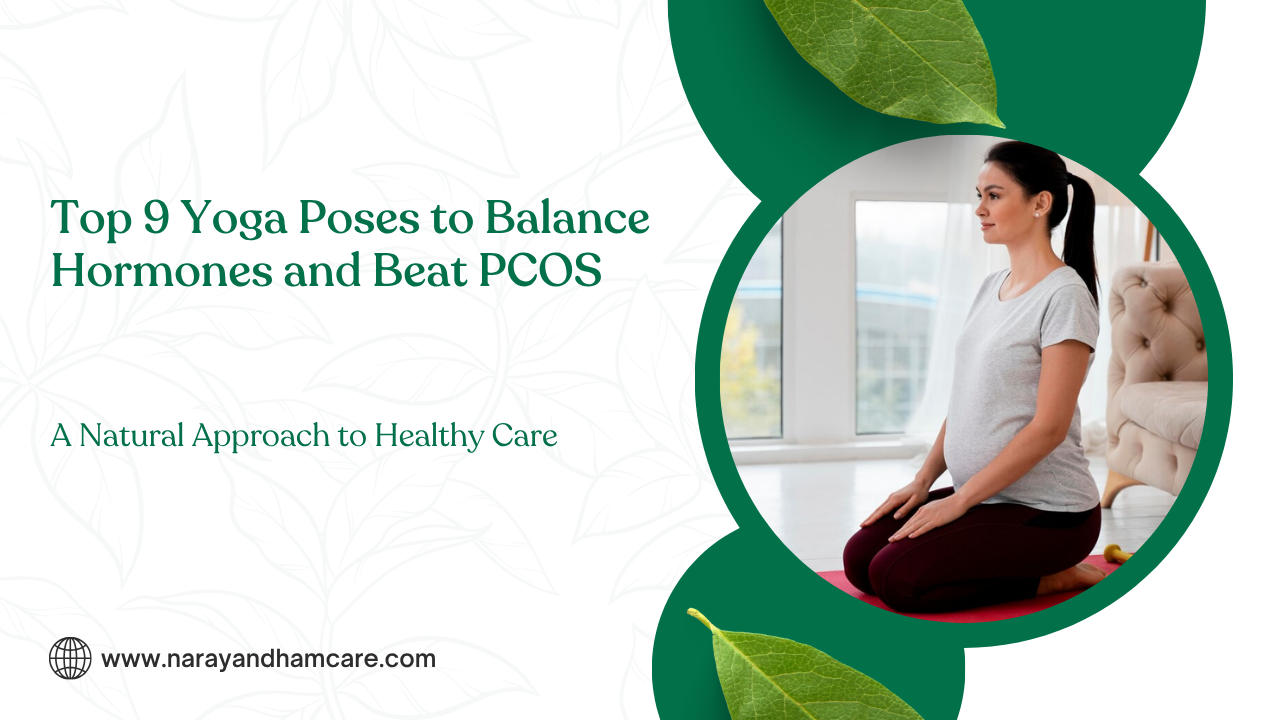PCOS: Introduction
(Polycystic Ovary Syndrome) is a common hormonal disorder that affects 1 in 10 women of reproductive age. It causes problems like irregular periods, acne, weight gain, and fertility issues.
While medicines can help, many women today are turning to natural methods like yoga to manage. Yoga helps calm your body, reduce stress, and most importantly, balance your hormones.
In this blog, we’ll explain why yoga is good, share the top 9 yoga poses that are proven to help, and give you tips to practice safely at home.
Problem
Mainly caused by a hormonal imbalance. In, the body produces more androgens (male hormones), which disturb ovulation and the menstrual cycle.
Stress, poor lifestyle, unhealthy food, and lack of physical activity make worse. Many women feel tired, anxious, and frustrated because of it.
But here’s the good news: Yoga is a natural and effective way to heal PCOS from the root.
Symptoms of PCOS
Some common signs that your body may be affected by include:
- Irregular or missed periods
- Weight gain or difficulty losing weight
- Acne or oily skin
- Hair thinning or hair loss
- Unwanted facial or body hair
- Trouble getting pregnant
- Mood swings, anxiety, or depression
- Fatigue and low energy
If you have any of these symptoms, it may be time to check with a doctor and also try yoga for hormonal balance.
Solution: 9 Best Yoga Poses for PCOS & Hormone Balance
Practicing yoga daily helps reduce stress, improve blood flow to the ovaries, and balance insulin and hormone levels. Below are the best yoga poses relief:
1. Baddha Konasana (Butterfly Pose)
This pose opens the pelvic region and improves blood circulation to the ovaries. It also helps reduce menstrual pain.
How to Do:
Sit with your legs stretched. Bring the soles of your feet together and hold them. Gently flap your knees up and down like butterfly wings.
Keywords: yoga at home, yoga for periods, butterfly pose benefits
2. Bhujangasana (Cobra Pose)
This pose massages the abdominal organs and strengthens the lower back, improving hormone function.
How to Do:
Lie flat on your stomach. Place your hands under your shoulders and slowly lift your chest while keeping your legs on the floor.
Keywords: cobra pose, yoga for hormone health, yoga routine
3. Dhanurasana (Bow Pose)
It stimulates the reproductive organs and boosts digestion, both of which help with symptoms.
How to Do:
Lie on your stomach, bend your knees, and hold your ankles. Lift your chest and legs together like a bow.
Keywords: dhanurasana, yoga for hormonal imbalance, natural exercise
4. Setu Bandhasana (Bridge Pose)
This calming pose balances thyroid function, opens the chest, and relieves stress.
How to Do:
Lie on your back, bend your knees, and keep feet flat. Lift your hips and chest upward while keeping arms beside you.
Keywords: bridge pose benefits, yoga for thyroid, stress-relief yoga
5. Supta Baddha Konasana (Reclining Butterfly Pose)
A gentle pose for deep relaxation and stress relief. It calms the nervous system and supports hormonal harmony.
How to Do:
Lie on your back, bring feet together, and let your knees fall to the sides. You can place cushions under your knees for support.
Keywords: yoga for anxiety, relaxation pose, hormone balancing asana
6. Marjaryasana-Bitilasana (Cat-Cow Pose)
This dynamic stretch boosts circulation and gently massages the reproductive organs.
How to Do:
Start on all fours. Inhale, lift your chest (cow pose); exhale, round your spine (cat pose). Repeat slowly.
Keywords: cat-cow yoga, menstrual cycle yoga, hormone-friendly yoga flow
7. Shavasana (Corpse Pose)
This final relaxation pose is important to absorb all the benefits and reduce cortisol (stress hormone) levels.
How to Do:
Lie on your back with legs apart and arms relaxed. Close your eyes and breathe deeply for 5–10 minutes.
Keywords: stress relief, yoga for calming hormones, deep rest yoga pose
8. Paschimottanasana (Seated Forward Bend)
This pose helps regulate periods and soothes anxiety.
How to Do:
Sit with legs straight. Inhale, raise your arms. Exhale, bend forward and try to touch your toes.
Keywords: yoga for period problems, forward bend, natural treatment
9. Malasana (Garland Pose)
A deep squat that opens the hips and supports digestion and reproductive health.
How to Do:
Squat with feet flat on the floor. Keep your hands in prayer pose and elbows pushing your knees outward.
Keywords: hip opening yoga, yoga for fertility, hormone detox pose
Yoga Tips for PCOS
- Practice yoga for at least 20–30 minutes daily.
- Combine yoga with deep breathing and meditation.
- Wear comfortable clothes and stay hydrated.
- Practice on an empty stomach.
- Do not push yourself—go slow and be kind to your body.
Frequently Asked Questions (FAQ)
Q1. Can yoga cure PCOS completely?
A: Yoga helps manage PCOS naturally by reducing stress and balancing hormones. It is not a cure, but it brings great long-term relief.
Q2. How often should I do yoga for PCOS?
A: Practicing 5 to 6 days a week can give excellent results. Even 20 minutes a day can make a big difference over time.
Q3. Which yoga pose is best for hormonal balance?
A: Butterfly pose (Baddha Konasana) and Bridge pose (Setu Bandhasana) are especially good for hormone balance.
Q4. Is yoga safe during periods?
A: Yes, gentle poses like Supta Baddha Konasana and Shavasana are safe and helpful during periods. Avoid deep twists or heavy inversions.
Q5. Can yoga help with weight loss in PCOS?
A: Yes. Yoga improves metabolism, reduces belly fat, and lowers insulin resistance—all important for weight loss .
Conclusion
feel challenging, but you don’t need to fight it alone or with only medicine. Yoga is a natural, simple, and powerful tool that can help balance hormones, regulate periods, and calm your mind.
With consistent practice of these 9 best yoga poses for, many women have seen great improvements in their mood, cycle, skin, and energy.
You don’t need to be perfect. Just begin. Your body will thank you.
Have you tried yoga for PCOS before? Share your experience or ask questions in the comments below. Let’s support each other on this journey





